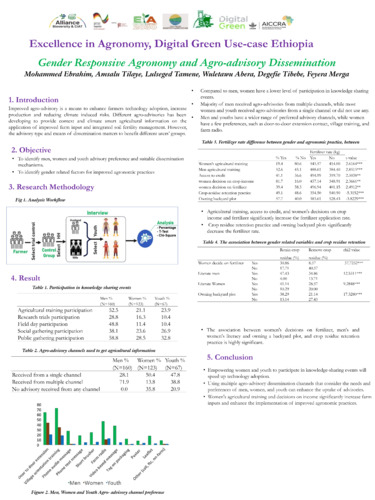Gender Responsive Agronomy and Agro-advisory Dissemination
Improved agro-advisories have been developing to provide context-specific and climate-smart agricultural information on the application of improved farm input, integrated soil fertility management and pest and disease surveillance. However, the advisory type and means of dissemination benefits different user groups. This study was conducted to identify men’s and women’s advisory preferences and suitable dissemination mechanisms. The study used survey data collected from 200 husbands and 200 wives at Amhara, SNNP and Oromia region of Ethiopia. Descriptive statistics, frequency and logistic regression were applied to the analyses of gender component response. The survey data was complemented with men’s and women’s focus group discussions. Even though women contribute up to 75% of the farm labor, compared to men they have lower level of extension contacts, participation to agricultural training, field days and other capacitybuilding activities. The current agro-advisory type and means of dissemination do not consider their needs and time preference. Around 80% of women received agricultural information from single channel while nearly 70% of men received advisories from multiple channels through multiple advisory forms. Nearly 95% of women and men need new agro-advisories in the form of orientation training, farm radios, videobased messages, and door-to-door extension services. Agricultural and marketing radio programs should consider women’s free time. Households with multiple agro-advisory channels are more likely to adopt new wheat varieties. The shorter distance from the farmer training center positively influences the use of multiple agro-advisory forms.

